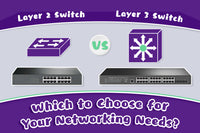Contents
Computer networks form the backbone of modern communication and data transmission. Computer networks allow different devices to communicate with each other in homes, businesses, or cities, enabling browsing, data analytics, and other activities. The computer network architecture defines how network devices are structured, how they transmit data, and how resources are shared. This article aims to explain everything about network architecture.
What is Network Architecture?
Network architecture is a framework that defines the design, structure, and components of computer networks, as well as how they operate. It includes the network’s physical and logical layout, hardware and software components, the way network devices are connected, and communication protocols. The architecture of computer networks is essential because it can affect the performance of the whole system. Additionally, a well-designed network architecture also facilitates network security.
There are many ways to design network architecture, depending on different network scales and purposes. Below is a brief overview of common network types based on different classifications:
- Based on Coverage: Global Internet Network, Wide Area Network (WAN), Metropolitan Area Network (MAN), Local Area Network (LAN), Campus Area Network (CAN), Personal Area Network (PAN).
- Based on Users and Special Purposes: Public Network, Private Network, Virtual Private Network (VPN), Storage Area Network (SAN).
Layers of Network Architecture: OSI Model
Most layered network architectures adopt the Open System Interconnection (OSI) model. The OSI model is a framework that divides the network communications into 7 layers. Established in the 1980s, the OSI model has become the standard for network infrastructure and communication protocols. Here is an overview of the seven layers in the OSI model.
Layer 1 - Physical Layer
As the lowest layer in the OSI model, the physical layer transmits individual bits from source devices to received devices over physical channels like cables, network hubs, or modems. The physical layer is also known as the hardware layer because it handles electrical, optical, or radio wave signals used in communications. The physical layer defines the hardware aspects of data transmission, including how data flows between different devices and how different nodes are physically arranged within the network.
Layer 2 - Data Link Layer
The data link layer ensures reliable and error-free transmission of data frames from node to node. It also controls data flow to avoid overwhelming the source and destination devices. This layer is divided into two sublayers: Media Access Control (MAC) and Logical Link Control (LLC). Logical Link Control (LLC) handles flow control and error detection, notifying the upper layers. Media Access Control (MAC) is used to track data using MAC addresses in each frame. Typical devices at this layer are switches and bridges, which help control traffic and manage communication.
Layer 3 - Network Layer
The network layer is responsible for selecting the best path to deliver data from the source to the destination devices. It divides the data into small packets for easy transfer between different devices. The network layer is also responsible for ensuring the packet reaches the correct destination by IP addresses. Routers are typical devices that operate at this layer.
Layer 4 - Transport Layer
This layer coordinates data transmission, adapting mechanisms such as flow control, error checking, and acknowledgment of successful data transmission. It may perform segmentation of long data streams and reassemble them at the receiving end. The main protocols of the transport layer include Transmission Control Protocol (TCP), User Datagram Protocol (UDP), etc.
Layer 5 - Session Layer
The session layer functions as a bridge between the transport and presentation layers. It helps start and stop traffic between two endpoints and then collect data for the presentation. The session layer allows for common functions such as session management, user login, authentication, etc., and also ensures security. By efficiently controlling the flow of data, the session layer plays a crucial role in saving bandwidth and processing power.
Layer 6 - Presentation Layer
The presentation layer translates application data into a format suitable for network transmission, or conversely converts data and graphics into a display format for the application layer. Character encoding, data compression/decompression, encryption and decryption all take place at this layer.
Layer 7 - Application Layer
This is the top layer of the OSI model and the layer closest to the end user. The application layer determines the nature of communication between processes, provides interfaces for users to interact with other users, servers, computers, ..., and allows applications to share resources, handle messages, and access remote files through various high-level protocols.
Components of Network Architecture
Network architecture defines every aspect of the network infrastructure, including hardware, software, protocols, physical connections, transmission media, and layout methods. The following section covers some essential components in a network architecture.
- Hardware: Hardware elements are vital to network architecture, and include essential devices like routers, switches, servers, firewalls, and gateways as well as end-user devices like computers and laptops. These hardware components are designed to facilitate communication within the network.
- Transmission Media: The transmission media usually refers to the physical or virtual connections between hardware devices. These connections can be either wired or wireless. Wired transmission media include twisted pair cables, coaxial cables, and fiber optic cables. Wireless transmission uses radio waves, microwaves and even infrared signals, with common technology like Wi-Fi, and 4G or 5G cellular networks. The choice of different transmission media relies on various factors, including network speed, reliability, security, and overall costs.
- Protocols: Protocols are rules enabling data transfer between devices. Without these protocols, devices would be unable to effectively communicate with each other. There are many protocols based on the type of data. Typical protocols include IP (Internet Protocol), TCP (Transmission Control Protocol), HTTP (Hypertext Transfer Protocol), and so on.
- Topology: Topology refers to the network structure, specifically how its devices and nodes are arranged within a network. Common network topologies include peer-to-peer, bus, ring, star, daisy chain, mesh, tree, hybrid, etc. They feature varying performance, scalability, fault tolerance and manageability. Modern networks usually employ a hybrid topology, combining multiple topologies to leverage their strengths.
Network Architecture Types
Network architectures can be designed in various ways to meet different needs. Peer-to-peer architecture and client-server architecture are the two most common types of network architectures. In addition, there are also cloud-based and software-defined architectures.
Peer-to-peer Network Architecture
There is no centralized server in the peer-to-peer (P2P) architecture. Instead, each node or device functions as both client and server, directly sharing resources and data with other nodes. This decentralized setup is highly fault-tolerant and supports various applications, such as file sharing, content distribution and collaboration. The P2P network architecture can be structured or unstructured. It is cost-effective but lacks security.
Client-server Network Architecture
In the client-server architecture, the central server handles data storage, client request processing, network security and access control, while other client devices access resources and communicate with each other through the server. Most large-scale networks use the client-server model for its stability, security and scalability. Dedicated servers enhance performance and efficiency by centralized management and backup. The World Wide Web is a typical example of client-server network architecture or tiered architecture.

Hybrid Network Architecture
The hybrid architecture combines both peer-to-peer and client-server architectures to enhance resource allocation, fault tolerance, and cost-effectiveness. In addition to a central server, it is also equipped with some edge devices that act as both servers and clients. This network architecture is typically used in the Internet of Things (IoT) where the combination of centralized and decentralized elements can effectively handle different network requirements.
Cloud-based Network Architecture
Cloud-based architecture is a modern design that uses cloud computing resources and services to manage network infrastructure. It is based on a cloud-based platform, offering flexibility and scalability. The cloud-based network architecture can be divided into private cloud, public cloud, and hybrid cloud.
Software-defined Network Architecture
Software-defined architecture uses software-based controllers or application programming interfaces (API) to govern physical networks and control traffic. It allows for real-time customization and modification. Software-defined WAN architecture provides a simple solution for building WANs.
Importance of Network Architecture Design
Proper architecture design helps IT departments greatly benefit from high-speed and reliable networks.
- Resiliency: Resilience means that the network should have high load bearing and fault tolerance. A good network architecture should consider redundancy and diversity of connection sources to maintain operation in the face of issues and failures.
- Future-proofing: Attach importance to the adaptability, flexibility and scalability of the network architecture, adoptinga modular design for example, so that it can be gradually upgraded with technological advances and respond to changing business needs.
- Security: The network architecture should fully implement security strategies such as firewalls, security protocols, encryption, VPNs, and intrusion detection systems to protect network resources and information from unauthorized access, cyberattacks and leakage.
- Efficiency: The network architecture should be designed and organized with the purpose of improving the quality of service (QoS) and facilitating efficient data transmission.
- Simplicity: The network architecture should be simplified as much as possible, for example by adopting a hierarchical design, to reduce complexity as well as error potential and facilitate management, maintenance, and troubleshooting.
- Cost-effectiveness: Network architecture design should pursue cost-effectiveness, optimize resource utilization, and seek to lower operating, maintenance, and system upgrade costs.
Summary
Network architecture defines the structural framework and operation mode of the network, affecting the network performance. Designing an effective network architecture requires expertise and meticulous planning to ensure a secure, reliable, and scalable network.
For more information on this topic, you can keep up on our blogs. While VCELINK offers general and basic information for our customers and other visitors to the website, it’s not professional advice.



Be the first one to comment.
Leave a comment